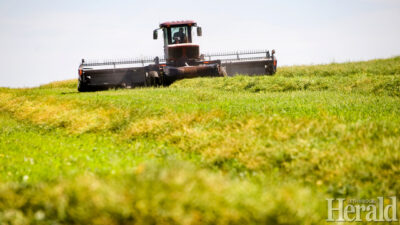Growing season uncertainty punctuated by a ‘big question mark’
By Cal Braid - Southern Alberta Newspapers - Local Journalism Initiative on April 25, 2024.
 Herald file photo -
A swather cuts a crop of canola during a past year in a field south of the city. Producers are hoping for more moisture as this year's growing season gets underway.
Herald file photo -
A swather cuts a crop of canola during a past year in a field south of the city. Producers are hoping for more moisture as this year's growing season gets underway.The growing season is at hand, and for months the forecast has been bleak. Heat without moisture makes for parched land and poor yields and the winter trended unwaveringly in a dry direction until February and March, when a few good snowfalls finally fell and sank in.
Grant Hunter, MLA for Taber-Warner, knows the concerns and remains optimistic that it wasn’t too little, too late.
“Obviously, we need to prepare for potential droughts. As you know, droughts have different levels,” he said, noting that Environment Minister Rebecca Schulz spent the winter pre-planning and setting up a task force that has MLA Justin Wright of Cypress-Medicine Hat sitting on it. “That (was) really about planning if the worst case happens and we don’t have the right amount of snowpack in the mountains, and we don’t have enough rain and snow on the flat.”
He’s not convinced that all is lost.
“So far, it’s actually looking pretty good. I get a weekly report on the snowpack in the mountains. Certainly in late February, March we started to actually see the numbers start to look a lot better. And we’ve gotten some pretty good snowfall out there. So that’s great. On the flat in most of my riding, we’ve had some pretty good snow cover. And we’ve had a few good storms come in, and the nice thing about it is it has not really blown away. It’s more kind of melted in. So as I’ve talked to different farmers they’re hopeful.”
David Westwood, general manager for the St. Mary River Irrigation District (SMRID), knows there are no guarantees and the weather can break bad at any time, but it can also break good. The best laid plans in forecasting can be upset by Mother Nature’s temperament on short notice. For better or worse.
“I think there’s a little bit of both,” Westwood said. “Based on what we know today and where storage is at and what the snowpack is at, and taking into account those inputs and combining that with additional precipitation that’s seen throughout the year, that is the big question mark.”
“That’s averaged over a lot of historical data. That should provide a total amount of ‘X’ water that should kind of get us so many inches per acre,” he said, referring to SMRID’s water allocation to each grower. “We get a lot of that information-the snowpack and the storage and the water data-assimilated for us by Alberta Agriculture and Irrigation. They start giving us monthly water supply forecasts and we really look at that closely to determine how we want to set our allocation.”
However, it’s an inexact science. “There are a lot of assumptions in there about traditional rainfall and temperatures. Those things are a useful predictor but not an absolute, ironclad forecast. Just like a weather forecast, many different agencies have great information based on how patterns have worked in the past, and what they see coming from the Pacific, over the Rockies, an El Nino year, all those kinds of things,” he said. “They try to predict weather two weeks out, but as you know, it doesn’t always come to fruition based on the data that they have. Things can change. That happened to us a little bit last year. Some of the predictions were for average rainfall and there was no rain really through the spring and into the summer, not anything meaningful. We got a little bit in August and then we got a little bit to help finish the harvest. The reality of it was we weren’t getting any May and June rain, and with the heat we had we saw irrigator demand go significantly higher.”
Westwood said that Deanna Klassen from the Alberta Financial Services Corporation spoke at the SMRID’s Annual General Meeting on April 3 to educate attendees about crop insurance. “I did ask her if they were seeing an uptick of interested people this spring purchasing or at least inquiring about crop insurance, and she said that yes they were. I think that when you’re going into a drought cycle, depending on how a farmer wants to do their risk mitigation plan, I think a lot of them look to crop insurance as a part of that plan to deal with what could potentially happen that summer.”
11-10

